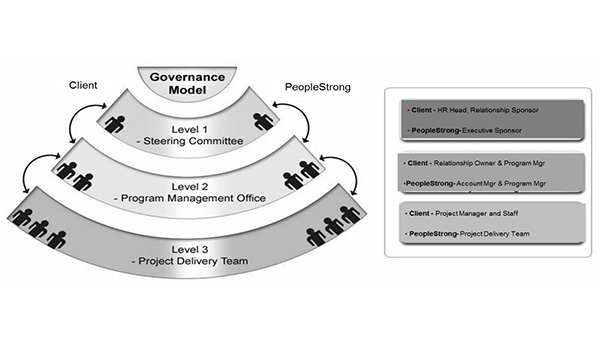As we move into the era of a more connected and integrated world, we not only have to be closer to the customer, we have to be almost flawless and effortless in providing peoples’ services.
And any organisation that decides to take this journey, must consider two prerequisites that are absolutely essential to kick start
- First, is your people services function, delivering well- integrated continuous experience!
- Second, is the HR function truly structured to provide for the first ask?
As we think & delve deeper into these questions, two fundamental asks of ‘what and how’ we do it definitely comes. The obvious answer is HR needs to have a center of excellence in People Services. One could name this as HR shared services, Employee experience center or whatever you may wish to- the basic premise of how and what of people services is to connect, engage and enable them!
Design and transitions is one of the most important aspect of making People Service delivery platform along with Governance. The designing should come with minimal disruption and maximum integration. With the evolution of transition and rising complexities, Process reengineering & Change management are the two critical items which virtually define the success or failure of establishing Lean & Smart HR. This, along with integrated planning and proper sequencing is the recipe for a well-designed People services delivery platform. Here are a few tips which can help to get maximum out of each stage.
- Process re-engineering:
- Mitigate the downside of non-flexibility of ERP systems & have technology at the core.
SaaS and cloud systems are extremely flexible to accommodate complex & customized HR processes for organisations. But, if your HR processes are not defined prior to implementation, all the configuration decisions will be made in a vacuum.
Any process re-engineering should have technology at its core with three main objectives:
- End user experience b) Ease of implementation c) Ability of the toll to engage with the millennial workforce.
- Set process benchmark & inculcate best practices.
Any re-engineering process requires tools like Lean Sigma, where most of the HR processes can be benchmarked against current competitors & industry leaders.
- Faster realization of process improvements and business benefits.
When we help clients identify process improvements, we often find that a new age HR technology providers may help automate and further enable process changes, and as the today’s workforce is very agile to accept the changes in a frequent interval, unlike before we roll out many improvements simultaneously for better change management.
- Change management:
Implementing HR shared service model requires change management that suits the culture of the current workforce of the organisation. While manufacturing industries prefer to have Road shows, Mailers & written documents to implement the change, new age companies in E-commerce are comfortable effecting change through webcasts and news flashes on their intranet portal. Whatever methodology that gets used needs to create a compelling vision for the future, built change coalition.
It is very important to understand the organisation’s history, culture and infrastructure to better prepare for the impact of change.
With experience of multiple implementations across industry sectors we have had some key learnings which have definitely helped us ensuring every migration a successful one:
- Shared Leadership: All the stakeholders need to co-own the process of defining Project Vision, Goal objective and success criteria’s. Most important the participation of Business leaders as this change would require sponsorship from Top leadership.
Core Team: Creation of cross functional Project core team with clear roles & responsibilities for all teams & its members is key to a successful migration. HR processes need participation from other departments as well. The Trend now is to link the KRA of Go- live with the core team to bring not only ownership but also accountability. A team for Project champions & Change agents is much needed to drive change in their respective area of operations.
- Governance: There should be a clear three layer Governance structure to successfully implement any shared service model. These layers specifically focus on transactional, tactical and strategic aspects. While on the ground operations team focus on transactional and tactical points on a frequent basis, the steering committee should meet on the agreed timeline to drive the project vision.

- Communication: Communication throughout the process is vital to keep everyone informed and highly motivated. The extent to which the change is effectively communicated has a direct bearing on its success or failure. Sometimes, change involves delivering some difficult messages and these need to be communicated in an empathetic and supportive way.
- Integrate planning and identifying risks in advance
Organisations need to delve deeper into the requirements of migration, to identify risks and dependencies such as SME availability, travel & logistics, business seasonality, regulations & geopolitics.
- Sequence the phases of the transition program for on-time transitions
The parameters to be considered for effective sequencing of the transition phase:
- Volume: Organisations can prioritize transition of process by locations and carry forward the lessons learned in one location to the others.
- Technology Adoption: If there are different systems implemented in different locations, processes, or business units, it will be prudent to analyse the IT landscape to decide whether to harmonise it first and then embark on the transition journey or vice versa.
- Business Spread: In some cases, it is beneficial to create shared service for each tower (process, function, business unit). Then, they should onboard key stakeholders in those functions onto the desired process.
- Standardisation: harmonized standard process can be transitioned earlier to help realise faster benefits.
There is no ‘one size fits all’ when it comes to the migration phase of Lean & Smart HR implementation. So choose the method and the tools that best suit your organisation needs. Having the right transition can bring in dedicated expertise, scalable project management capabilities, and industry best practices to ensure smooth and seamless transition.

